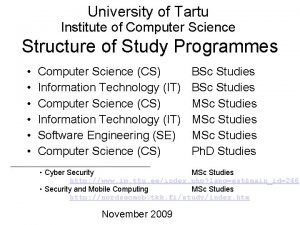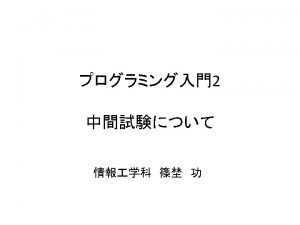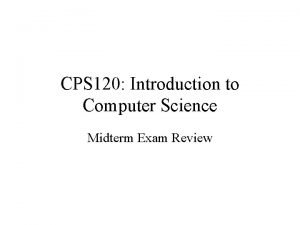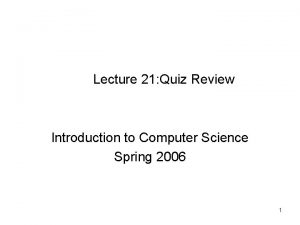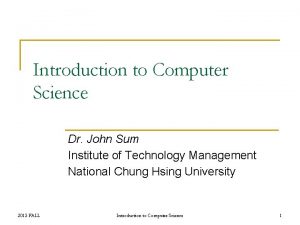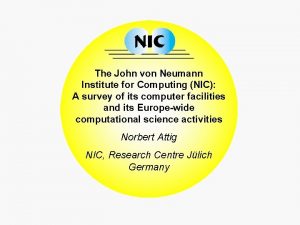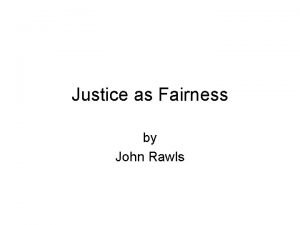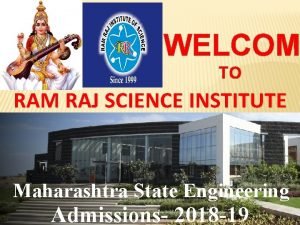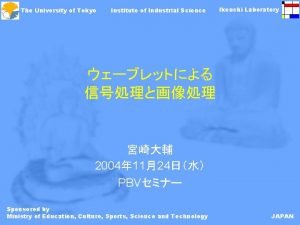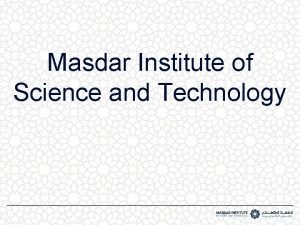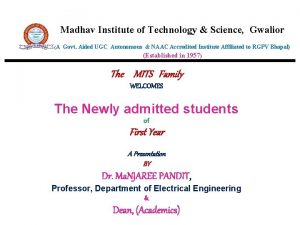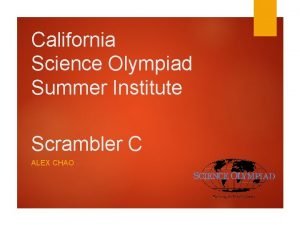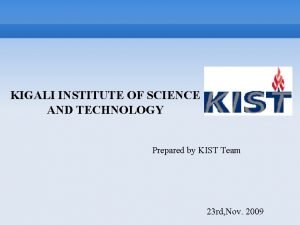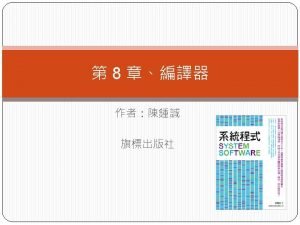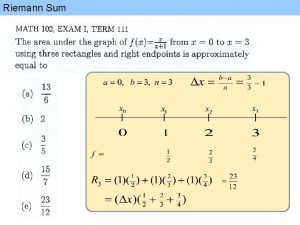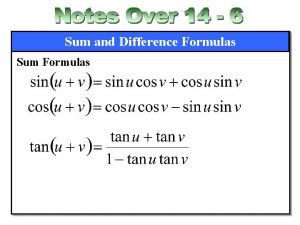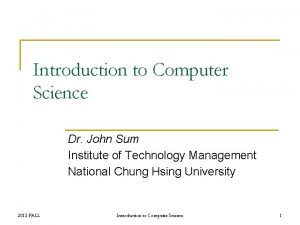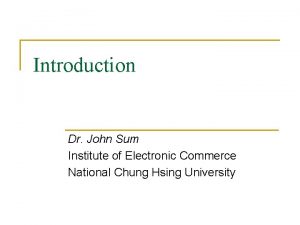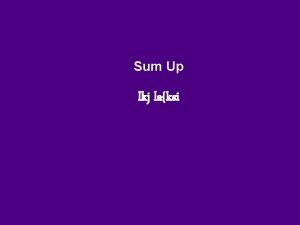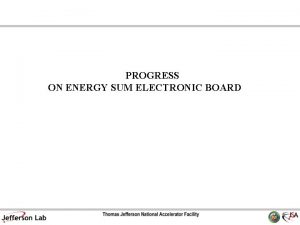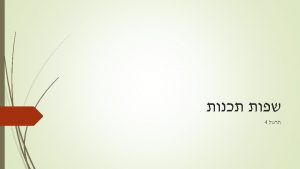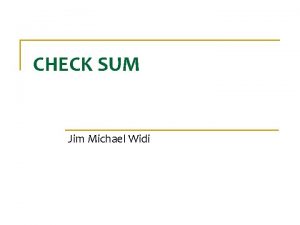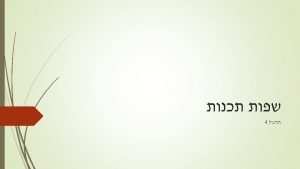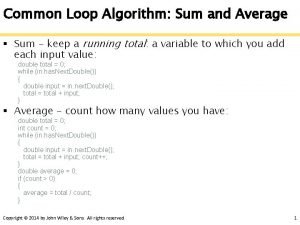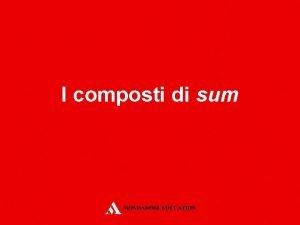Introduction to Computer Science John Sum Institute of



















- Slides: 19

Introduction to Computer Science John Sum Institute of Technology Management National Chung Hsing University 2013 FALL Introduction to Computer Science 1

Lecture Outline n n n About John Sum About the Course History of Computers q q q n Computer is …, computer can … Simple versus complex computers Important inventions Generations of computers Computer programs Review questions Youtube video on “History of Computers” 2013 FALL Introduction to Computer Science 2

About John Sum n n n John Pui-Fai Sum (沈培輝, Pei-Hui Shen) Professor, Institute of Technology Management Office: Room 821, CSSM Building Email: pfsum@nchu. edu. tw Homepage: web. nchu. edu. tw/~pfsum Office hours: By appointment 2013 FALL Introduction to Computer Science 3

About John Sum n n n Taiwan-HK-Chinese, born and educated in HK Moved to Taiwan in Feb 14, 2005. Got Taiwan citizenship in August 1, 2007. BEng in Electronic Engineering, Hong Kong Polytechnic University MPhil, Ph. D in Computer Science & Engineering, Chinese University of Hong Kong. Lang: Cantonese (vg), Mandarin (ok); English (nb) 2013 FALL Introduction to Computer Science 4

About the Course n This course has been included in the following programs. q q n Compulsory course in the College of Management Bachelor in Business Administration (BBA) program. Elective course in the College of Agriculture & Natural Resources International Bachelor Program of Agribusiness (IBPA). Medium of instruction of this course is English. 2013 FALL Introduction to Computer Science 5

About the Course n n Introducing basic concepts of computers Teaching q q n Lectures with lecture notes and review exercises Tutorial sessions, and review lectures (make-up classes) Assessment q q q Individual assignments, group assignments Class Test I&II, Mid-term & Final Exams Bonus assignment(s) 2013 FALL Introduction to Computer Science 6

History of Computers 2013 FALL Introduction to Computer Science 7

Computer is …, computer can …, network of computers can … n n Computer is part of an information system. Computer is able to process data (computation) and store data. Standalone computers can do many things. q File storage q Word Processing (e. g. MS Word) q Data storage (e. g. MS Access) q Data analysis (e. g. MS Excel, SAS, SPSS) q Computer games (e. g. Games in Window) q Scientific researches (e. g. Matlab, Mathematica) q Drawing and photo editing (e. g. Corel Draw, Photoshop) q Reading document (e. g. MS WORD, Adobe Reader) q Music/Video (e. g. Real Player, Media Player) With network technologies, computers can do even more. 2013 FALL Introduction to Computer Science 8

Simple versus complex computers n n No matter what, the basic function of a computer is to perform computation. Simple computing machines. q q n Complex computing machines q q q n Egyptian Abacus, Chinese Abacus Simple to use, calculating by hand (human being is the machine) Jacquard Looms Babbage Difference Machine Programmable, calculating by machine Even more complex computing machines q Mainframe, workstations, PC, smartphones 2013 FALL Introduction to Computer Science 9

Chinese Abacus Babbage Difference Machine 2013 FALL Introduction to Computer Science 10

Jacquard Looms 2013 FALL Introduction to Computer Science 11

Simple versus complex computers n Abacus and Babbage Difference Machine are designed for special use. q q q n Abacus is for addition. BDM is for solving polynomial. Instructions to use are simple, i. e. easy to learn. Contemporary computers are designed for general use. q q Their instructions to use (the hardware) are complex, i. e. difficult to learn. To have a complete understand of how to use, enroll the computer science program. 2013 FALL Introduction to Computer Science 12

Important Inventions n n n n n 1800 Electricity (Alessandro Volta) 1801 Jacquard Looms (Joseph Marie Jacquard) 1836 Differential Analyzer (Gaspard-Gustave Coriolis) 1837 Analytic Engine (Conceptual machine, by Charles Babbage) 1878 Filament Lamp (Thomas Edison) 1878 Power generators, driven by steam engines 1888 Babbage Difference Machine (Henry Babbage) 1890 Tabulating Machine (Counting Machine, by Herman Hollerith) 1904 Vacuum Tube (John Ambrose Fleming) 1906 Diode, triode, other electronic components 2013 FALL Introduction to Computer Science 13

Generations of Computers n First Generation Computers (Use of vacuum tubes) q 1936 Algorithm, computation, Turing Machine (Conceptual computer, Alan Turing) q 1937 -41 Atanasoff–Berry Computer (First digital electronic computer, not programmable, Iowa State College) q 1941 German Z 3 (First store-program general purpose computer, Konrad Zuse) q 1943 British Colossus Computers (Tommy Flowers, UK) q 1944 Mark I (Howard H. Aiken designed, IBM built) q 1945 Von Neumann Model (Conceptual stored-program computer, John von Neumann) q 1946 ENIAC (Electronic Numerical Integrator and Computer, John Mauchly and J. Presper Eckert, University of Pennsylvania) q 1948 ENIAC was enhanced to be programmable 2013 FALL Introduction to Computer Science 14

Generations of Computers n Second Generation of Computers (Use of Semiconductors) q q q n Third Generation of Computers (Use of IC) q n 1947 Transistor (John Bardeen and Walter Houser Brattain, William Shockley at Bell Lab) 1953 First Transistor Computer (University of Manchester, UK) 1952 IBM 701 1964 IBM System/360 (Made of transistors and microchips) Fourth Generation of Computers (Microprocessors) q q 1965 Programma 101 1971 Intel 4004 CPU 2013 FALL Introduction to Computer Science 15

Computer Programs n Computers q q q n Perform calculation and store data Non-programmable or programmable Input/Output devices for users Programs q q Stored in a set of punch cards or memory Direct control the mechanical machine Direct control the CPU by electric signals Machine code Low level programs (Assembly Lang) Middle level programs (C Language) High level programs (SQL) Application programs (Access) 2013 FALL Introduction to Computer Science 16

Review Questions n n n What is the fundamental purpose of a computer? Babbage Difference Machine is a mechanical or electronic computer? What is the contribution of Thomas Edison in the history of computer? When did IBM manufacture her first digital electronic computer? What major inventions leading to the first, second, third and fourth generations of computers? To control a computer, we need _____. 2013 FALL Introduction to Computer Science 17

Review Questions n In accordance with the level of difficulties, what should be the correct ranking of the following skills. q q q q Knowing how to use Window. Knowing how to build Window. Knowing how to use CPU. Knowing how to build CPU. Knowing how to use MS WORD. Knowing how to build MS WORD. Knowing how to design a new model of CPU. 2013 FALL Introduction to Computer Science 18

Additional Information n History of Computers q n BBC Documentary: History of Computers q n http: //www. youtube. com/watch? v=2 JPa. VZ 8 j. Uj 0 http: //www. youtube. com/watch? v=Nbhbss. XWDAE &feature=rellist&playnext=1&list=PLDE 8 FF 57 B 9 E F 2 D 4 D 2 History of Internet q http: //www. youtube. com/watch? v=9 h. IQjr. MHTv 4&f eature=related 2013 FALL Introduction to Computer Science 19
 Institute of computer science university of tartu
Institute of computer science university of tartu Sum0
Sum0 My favourite science
My favourite science Think central science fusion
Think central science fusion Introduction to computer science midterm exam
Introduction to computer science midterm exam Introduction to computer science midterm exam test
Introduction to computer science midterm exam test C++ code
C++ code Python programming an introduction to computer science
Python programming an introduction to computer science John sum
John sum John sum
John sum John von neumann institute
John von neumann institute Justice and fairness
Justice and fairness Ramraj classes nashik
Ramraj classes nashik Spike unist
Spike unist Institute of industrial science the university of tokyo
Institute of industrial science the university of tokyo Masdar institute of science and technology
Masdar institute of science and technology Madhav institute of technology and science
Madhav institute of technology and science What is this
What is this Korea institute of sport science
Korea institute of sport science Kigali institute of science and technology
Kigali institute of science and technology
